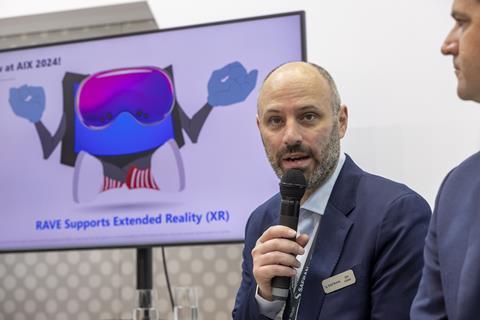Safran Passenger Innovations (SPI) is now offering its 4k HDR MiniLED display for all in-flight entertainment screens on its RAVE IFE system.
Launched last year for screens from 17.3 inches up to 32 inches, the displays are now available on 13.3 and 15.6 inch screens too. It means the technology is available across all cabin classes.

“We also made a few little tweaks,” noted Ben Asmar, SPI’s vice-president, products and strategy. “To really make sure the picture pops and the colour’s perfect, we’ve now also embedded quantum dot technology into all of our displays. And we’ll also be using a powerful new processor by converting for the first time to a Snapdragon processor.
”It means we now have, on a widebody aircraft, 300-plus very powerful processors that can be knitted together into our cloud computing platform to really open up the possibilities of what can be done on an aircraft. These new displays will be available to our customers from about 2027 onwards.”
Another new innovation is RAVE Cloud Services which comes with two elements.
“The first is a distribution system,” explains Jared Siqueland, the company’s senior vice-president, global sales and marketing. “This is a system and service that allows the aggregation of data – such as content, software and analytical data – and to determine where and when that data gets sent. We’re starting to break the traditional methods of, for instance, loading software, loading content.
“If you think about content today for an IFE system, everything gets loaded and away goes the aircraft. Through this service, we’re going to be able to start breaking that traditional method and load pieces of content essentially at any time or anywhere, no longer requiring the aircraft to be on the ground.
“The second element of the new cloud services is what we’re calling RAVE Cloud Computing,” Siqueland continues. “This leverages all of the processing power on board at each of the RAVE seats, allowing these seats to be able to talk to each other, share content, have hundreds and hundreds of terabytes of content – more content than an airline can consume in the foreseeable future.”
Asmar also notes he development of a new accessible mode for IFE. “I think our industry largely has not focused in this area well in the last probably 10 years and really we need to do better,” he acknowledges. “What we’ve done at SPI is work with the disability communities as well as some airline customers to develop a way for people that have disabilities to interface with the IFE, possibly for the first time ever.
”In this product, we’re broadening the reach of IFE services on board to as many passengers as we can. It will continue to be developed as we go. As we learn more and get more feedback, we plan to enhance it to provide even better services.
Asmar says: ”We’re partnering with Air New Zealand as the launch customer for introduction later this year, sometime around Q4. We’re also partnering with Flight Path 3D for an accessible IFE experience.”
SPI is also opening up its platform to third party developers to allow them to make applications that can run on the RAVE IFE system.
“We don’t propose that we can develop all the software out there that airlines would like to run as we get further into digitalisation, nor should we,” Asmar says. “We really want to give our customers the ability to come up with their own digital applications and have an easy way to deploy them to the aircraft using our cloud services.
“In fact, in Q4 this year we’ll have one airline that’s developed three of their own apps that are now seamlessly integrated into the platform. The passenger will feel it as one integrated IFE system, but it’s actually our software running alongside three different applications developed by someone else,” he says.





























